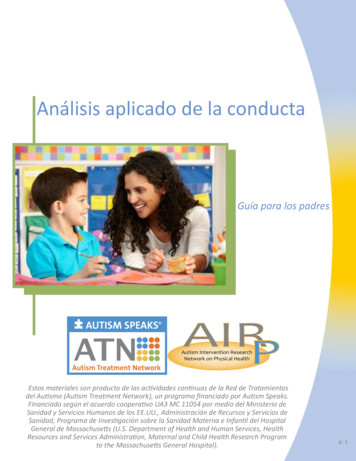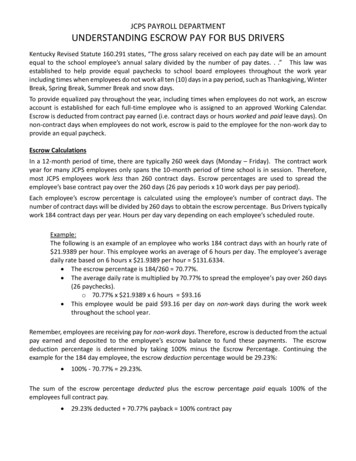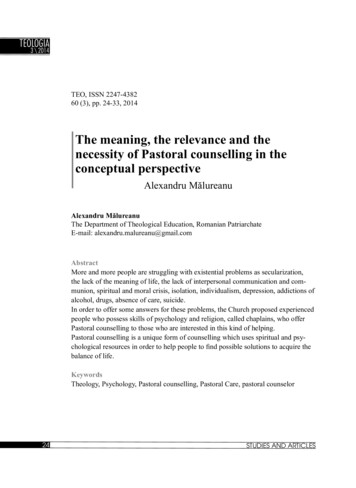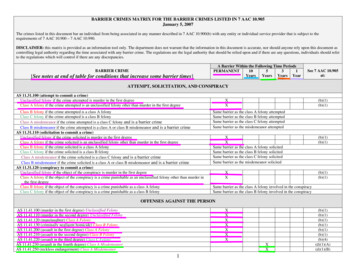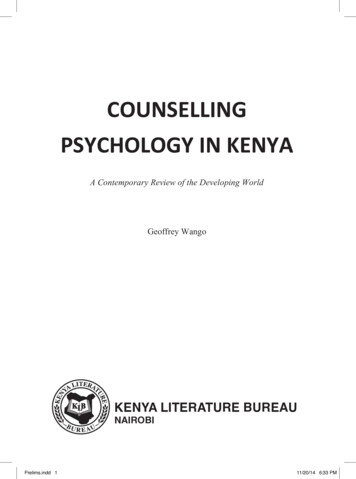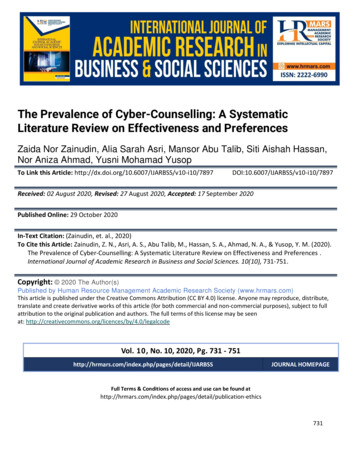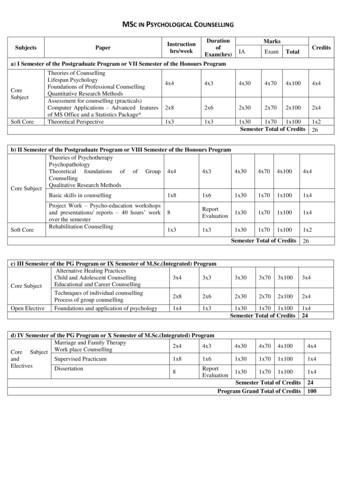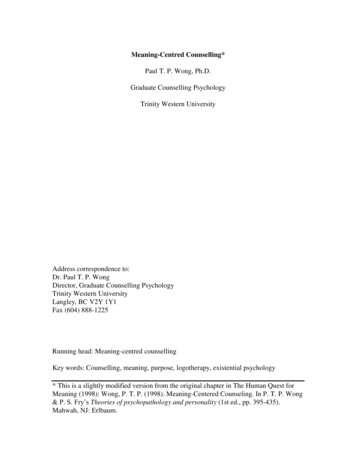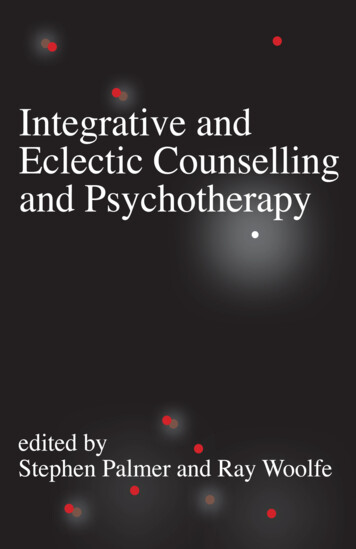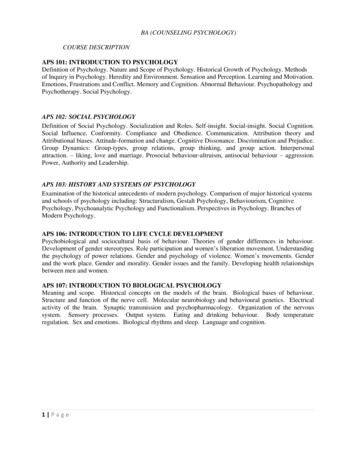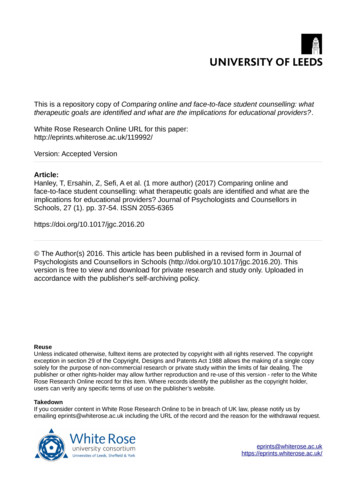
Transcription
This is a repository copy of Comparing online and face-to-face student counselling: whattherapeutic goals are identified and what are the implications for educational providers?.White Rose Research Online URL for this n: Accepted VersionArticle:Hanley, T, Ersahin, Z, Sefi, A et al. (1 more author) (2017) Comparing online andface-to-face student counselling: what therapeutic goals are identified and what are theimplications for educational providers? Journal of Psychologists and Counsellors inSchools, 27 (1). pp. 37-54. ISSN 2055-6365https://doi.org/10.1017/jgc.2016.20 The Author(s) 2016. This article has been published in a revised form in Journal ofPsychologists and Counsellors in Schools (http://doi.org/10.1017/jgc.2016.20). Thisversion is free to view and download for private research and study only. Uploaded inaccordance with the publisher's self-archiving policy.ReuseUnless indicated otherwise, fulltext items are protected by copyright with all rights reserved. The copyrightexception in section 29 of the Copyright, Designs and Patents Act 1988 allows the making of a single copysolely for the purpose of non-commercial research or private study within the limits of fair dealing. Thepublisher or other rights-holder may allow further reproduction and re-use of this version - refer to the WhiteRose Research Online record for this item. Where records identify the publisher as the copyright holder,users can verify any specific terms of use on the publisher’s website.TakedownIf you consider content in White Rose Research Online to be in breach of UK law, please notify us byemailing eprints@whiterose.ac.uk including the URL of the record and the reason for the withdrawal terose.ac.uk/
RESEARCH ARTICLETitle:Comparing online and face-to-face student counselling: what therapeutic goals areidentified and what are the implications for educational providers?Authors:Terry Hanley, Senior Lecturer in Counselling Psychology, University of ManchesterZehra Ersahin, Counselling Psychologist in Doctoral Training, University ofManchesterAaron Sefi, Research and Outcomes Lead for XenzoneJudith Hebron, Research Fellow, University of ManchesterDeclaration:We confirm that this manuscript is an original piece of work that has not beensubmitted nor published anywhere else.All authors have read and approved the paper and have met the required criteria forauthorship.Suggested Running Head:Comparing online and face-to-face student counsellingCorrespondence:Terry HanleyEmail: terry.hanley@manchester.ac.ukPost: Rm.A6.15. Ellen Wilkinson Building, University of Manchester, Oxford Road,Manchester. M13 9PLTelephone: 0161 2758815Word Count: 5720 (inc. abstract and references)
TitleComparing online and face-to-face student counselling: what therapeutic goalsare identified and what are the implications for professionals working ineducational settings?AbstractOnline counselling is increasingly being used as an alternative to face-to-face studentcounselling. Using an exploratory mixed methods design, this project investigates thepractice by examining the types of therapeutic goals that 11 to 25 year olds identifyonline in routine practice. These goals are then compared to goals identified inequivalent school and community-based counselling services. 1,137 online goals(expressed by 504 young people) and 221 face-to-face goals (expressed by 220 youngpeople) were analysed for key themes using grounded theory techniques. Thisanalysis identified three core categories (1) Intrapersonal Goals, (2) InterpersonalGoals, and (3) Intrapersonal Goals directly related to others. Further statisticalanalysis of these themes indicated that online and face-to-face services appear to bebeing used in different ways by students. These differences are discussed alongsidethe implications for professionals working in educational settings.Key words: Adolescents, Online counselling; School-based Counselling; Youthcounselling; Goal-Oriented Therapy; Help-Seeking Behaviours
BackgroundThis project was completed in conjunction with KOOTH, a counselling and supportservice for 11-25 year olds in the United Kingdom (UK). It has been widely involvedin the development of services that are easy to access and youth friendly. As such, itprovides anonymous online counselling using a single point of access via a website(www.kooth.com) and face-to-face counselling within secondary schools andcommunity settings. All services are funded by external partners, such as LocalAuthorities and the National Health Service’s Clinical Commissioning Groups, andare free at the point of delivery. The counselling offered by the KOOTH service ispluralistic (Cooper & McLeod, 2011) and explicitly focused upon the goals that theindividuals accessing therapy identify alongside their counsellors. Below we outlinehow the literature related to the context of the service and this goal oriented approachfeed into the aims of this study.Developing accessible counselling for studentsYoung people and young adults are highlighted as a group that are at risk ofpsychological distress (e.g. Coleman & Brooks, 2009). As education providerscommonly have substantial contact with individuals during this life stage, they areincreasingly recognised as having the potential to become hubs for offering wholeschool and targeted social and emotional support (Department of Health, 2015). Suchinterventions have been linked to improvements in students’ social and emotionalcompetence, academic attainment and ability to engage with learning, improvementsin behaviour, and the reduction of mental health problems more generally(Department of Education, 2015; Durlak, Weissberg, Dymnicki, Taylor, &Schellinger, 2011). As a consequence, educational providers can be seen to beroutinely funding mental health services through their own budgets (e.g. Hanley,Jenkins, Barlow, Humphrey, & Wigelsworth, 2013), and the development ofappropriate and accessible targeted services, such as counselling, has become a majorconsideration for schools (e.g. Harris, 2013).When seeking psychological support, young people and young adults appear to lookincreasingly towards the Internet (Gray, Klein, Noyce, Sesselberg, & Cantrill, 2005).In response to this growing need, online counselling services have begun to developwith the hope of further increasing the accessibility of therapeutic services (Pattison,
Hanley, Pykhtina, & Ersahin, 2015). Notably, such services have emerged throughoutthe world – for example in Africa: Pattison, Hanley and Sefi (2012); Australia:Glasheen and Campbell (2009); and Europe: Vossler and Hanley (2010). Theseservices have been created to respond to national contexts and have been used inconjunction with, and as an alternative to, traditional face-to-face delivery (e.g.school-based counselling services). Interestingly, where counselling has beenaccessed by young people outside traditional healthcare settings (e.g. within schoolbased counselling) it is notable that the severity of presenting issues does not appearto vary (Cooper, 2013). There is even some indication that online presentations maybe more complex than some face-to-face settings (Sefi & Hanley, 2012).Benefits are reported for both those accessing and providing online counsellingservices. Young users report that they find the online environment safe and feel lessexposed, confronted and stigmatised (e.g. Hanley, 2012; King, Bambling, Lloyd, etal., 2006). Therefore, the anonymity of online counselling helps to ease thediscomfort of making what can be perceived as embarrassing disclosures. Further, theincreased ability and freedom to access such services is also suggested to enhanceclient autonomy in the therapeutic relationship, thus empowering the young person inthe therapeutic dyad (Gibson & Cartwright, 2013; Hanley, 2012). Counsellorsexpress similar positive sentiments. Specifically, they report that therapeuticrelationships can be more convenient and feel safer when working online with youngpeople (e.g. Bambling, King, Reid, & Wegner, 2008; Dowling & Rickwood, 2016;Glasheen, Campbell, & Shochet, 2013).In contrast to the benefits, challenges related to online practice with this group arealso reported within the literature. For instance, practical concerns are noted aroundthe infrastructure needed for such practice (Callahan & Inckle, 2012; Hanley, 2006)and the delivery of effective therapeutic interventions are also raised. In relation tothe latter, King, Bambling, Reid, and Thomas (2006) and King, Bambling, Lloyd, etal. (2006) report user concerns over the counsellor's ability to grasp their feelings (andvice versa), the limited exchange time in text format within the time constraints, andthe loss of immediacy in online practices. Therefore, although online counselling foryoung people is still an emerging field, it is an arena that is growing at pace and inneed of further consideration.
Goal Oriented TherapyTherapy that is oriented towards the goals of young people is increasingly beingadvocated by psychologists (e.g. Hanley, Williams, & Sefi, 2013). Therapeutic goalshave been described as the “internal representations of desired states” (Austin &Vancouver, 1996, p. 338). Therapeutic approaches that advocate the articulation ofgoals from clients often base this approach within existential philosophies that placeemphasis on the purposeful, and future-oriented nature of the human (e.g. Cooper,2015; Hanley, Sefi, & Ersahin, 2016). This position commonly aligns itself to theholistic stance of humanistic psychology (e.g. Bugental, 1964) and views clients asactive agents within the therapeutic process (Bohart, 2000; also see Gibson &Cartwright, 2013 for a discussion of agency in therapy with young people).Furthermore, within psychological literature, the focus upon goals in therapy hasparticularly gathered momentum in the concept of the therapeutic alliance (as firstdescribed by Arbor and Bordin (1979)). Within this conceptualization, goals areviewed alongside the therapeutic bond and tasks as key common factors of thetherapeutic relationship. The alliance has received much attention in the therapeuticresearch literature and been identified as a major contributor to successful therapeuticoutcomes for both adult (Horvath, Del Re, Flückiger, & Symonds, 2011) andadolescent populations (Shirk, Karver, & Brown, 2011).The goals with which individuals approach therapy are incredibly varied. A varietyof taxonomies have been developed to categorize these. For instance, the Berninventory (Grosse & Grawe, 2002) summarizes 1,031 goals articulated by 298 outpatients at a university clinic into five different categories: (1) coping with specificproblems and symptoms, (2) interpersonal goals, (3) well-being and functioning, (4)existential issues, and (5) personal growth. Similarly, Rupani et al. (2013) explored199 goals expressed by 73 young people who had accessed school-based counselling.These findings revealed that the goals fell into four major domains: (1) EmotionalGoals, (2) Interpersonal Goals, (3) Goals targeting specific issues, and (4) PersonalGrowth goals. As is evident within these two classification systems, taxonomies varyin their degrees of divergence and convergence.
Goal-oriented therapy refers to therapeutic practice in which interventions are focusedaround the specific goals that have been articulated by the client (or clients). As withthe therapeutic alliance, the consensus between the goal of the therapist and client isan element of the therapeutic relationship that meta-analyses report to have a positiveeffect upon the therapeutic outcome (Tryon & Winograd, 2011). With suchsentiments in mind, therapeutic approaches, such as Cooper and McLeod’s pluralisticframework for counselling and psychotherapy (2011), have been specifically devisedto harness the potential positive components of such a process. As well as beingutilized in adult populations, the pluralistic framework has also been suggested fortherapeutic work with young people (Hanley, Williams, et al., 2013). Within thisframework, goal articulation is viewed as an ethically-minded position supporting theclient to be actively involved in helping to orchestrate the therapeutic process (Hanleyet al., 2016).RationaleAs online therapeutic work becomes more commonplace for student populations,further examination of the type of work being undertaken is much needed. Thisproject therefore provides a significant exploration of the field by examiningcollaboratively developed therapy goals that are expressed in counselling sessions.Such investigation will help professionals to further understand not only the reasonswhy young people seek support online, but also to gain a sense of the impact of newtechnologies upon the types of goals that individuals seek to address in therapy.Identifying such factors will prove helpful to service providers, such as in educationalsettings, when considering whether to invest in such provision. With this in mind, thefollowing research questions were formulated for the study:1. What type of goals do young people identify as working towards during onlineand face-to-face therapy?2. How do the goals that young people articulate online and face-to-facecompare?3. Based upon the goals identified, how might online counselling services impactupon professionals working in educational settings?
MethodologyThis study utilized an exploratory mixed methods research design (Creswell, PlanoClark, Gutmann, & Hanson, 2003). Initially a qualitative approach (GroundedTheory) was taken to make sense of the wide variety of goals that had been articulatedduring the counselling sessions. Following this, statistical analysis (inferential anddescriptive) was used to compare the prevalence of the different types of goals thatwere reported in online and face-to-face settings.Data Collection: Procedure, participants, and ethical considerationsThe project involved collating the therapy goals of 11 to 25 year olds who used theKOOTH counselling services. All the data considered here was routinely collected bythe therapy services. Goals were formed collaboratively with counsellors at the outsetof counselling (or during regular review periods) using the organisation’s CounsellingGoal System (CoGS). A version of the CoGS was embedded within the online systemand a paper version used with face-to-face clients (see Appendix 1 for a blank versionof the form used in face-to-face work). This encourages clients to briefly articulategoals for counselling (e.g. “To explore why I feel people don’t like me”) and enablesachievement of goals to be reviewed quantitatively (regularly asking clients to ratewhether they have been met since their last meeting). The counsellors working for theservice were originally trained in a range of therapeutic approaches. All had receivedtraining in the process of supporting young people to articulate their goals forcounselling and those working online had also received training to work in thismedium.The counselling was either delivered online (using the online access pointwww.kooth.com) or face-to-face within a school or community setting. Althoughconfirmation of the service user’s location is required for the online service, nopersonally identifiable material is required for an individual to use it. This is incontrast to the face-to-face service where people are likely to have been referred by amember of the school staff. No record of the referrer was available at the time ofanalysis.
Within the online sample, 1,137 goals were collated from 504 young people duringthe time period December 2013 – July 2014 (74% identified themselves as female,with the mean age being 16.5 (median 16, SD 2.76). During the same period, 221goals were collated from 220 young people accessing face-to-face therapy (66% werefrom school based provision and 34% from services based in the local community;70% were female; and the mean age was 14 [median 14, SD 2.00]). Thedemographics of the service users here generally reflect the demographic make-up ofthe services more generally.The research was approved by the University Research Ethics Committee associatedwith the lead authors place of work. It adhered to the Code of Human ResearchEthics developed by British Psychological Society (2010) as well as the ethicalguidelines of the host organisation (Bond, 2004).Data AnalysisTechniques from the grounded theory approach were used to analyse the goals thathad been articulated by the young people for key themes (Charmaz, 2000). Theinductive nature of the analysis meant that previous conceptualisations of goaltaxonomies were not considered during the initial analysis stage. This naïve stancewas adopted so that the analysis would not be greatly influenced by the thinking ofothers and thus the analysis would be open to new themes (e.g. Rennie & Fergus,2006)Common protocols associated with grounded theory were utilized to develop ahierarchy related to the data in question (Strauss & Corbin, 1998). The goals that theyoung people reported (N 1,358 were divided into meaning units (MUs: see Rennie,Phillips, & Quartaro, 1988) and coded into representing categories by two membersof the research team. During this process a number of the goals were divided up so asto account for their multifaceted nature (MUs ultimately totalling 1,469). Onceagreement was reached on the categorisation of these lower order codes, explorationof the commonalities led to the creation of higher order categories. This constantcomparison across categories enabled the authors to reflect upon the internalconsistency of the developing model (Maykut & Morehouse, 1994). A third team
member was utilised as a means of checking the coherence of the analysis and tomediate any disagreement between the core coders.Once the qualitative data had been analysed for key themes, content analysis was usedto reflect upon the differences that were evident within the online and face-to-facedatasets (Krippendorff, 2013). Descriptive and inferential statistics were calculatedfor each layer of abstraction within the grounded theory analysis. A chi square testfor goodness of fit was then used with each of the core categories and subcategories todetermine whether the differences in the proportion of goals were statisticallysignificant. Where this was found to be the case, effect sizes were used calculatedusing Cohen’s(Cohen, 1992). These figures then provide discussion points forcomparisons to be made to the two modes of counselling being considered.Findings and DiscussionTo start this section, a summary of all of the goals that were articulated is provided.This involves presenting the three core categories that emerged alongside thesubsequent lower order sets of subcategories. Following on from this, further analysisis provided which specifically reflects upon how the goals that were articulated differin online work when compared to face-to-face work.Identifying Therapeutic GoalsThe goals individuals articulated at the beginning of counselling (both online andface-to-face) were conceptualized under three core categories, namely (1)Intrapersonal Goals, (2) Interpersonal Goals and (3) Intrapersonal Goals directlyrelated to others. The two former core categories, Intrapersonal Goals andInterpersonal Goals, resonate explicitly with other taxonomies of therapeutic goalsrelated to work with young people and young adults (e.g. Bradley, Murphy, Fugard,Nolas, & Law, 2013; Rupani et al., 2013). In between these areas however, therewere a substantial number of goals that young people identified that did not fit neatlywithin these two core categories. This led to the creation of the third category,Intrapersonal Goals directly related to others, to represent the types of goals in whichindividuals expressed the hope to work on intrapersonal goals that had a direct
relationship to others (e.g. friends, family members or organisations). These goalscontrast to those Intrapersonal Goals noted above which are solely articulatedtowards internal processes. Figure 1 outlines definitions of these three overarchingcore categories.Figure 1: Definitions of the 3 Core CategoriesIntrapersonal Goals (968 MUs)Intrapersonal goals refer to the type of goals existing or forming within the individualself or mind, targeting desired within-person consequences in relation to self.Intrapersonal goals formed the largest core category of the model, representing 65.9%of all the MUs within the goals articulated.Interpersonal Goals (114 MUs)Interpersonal goals refer to the types of goals associated with relationship processes,partners or correspondences. They accounted for 7.8% of all the MUs within the goalsarticulated.Intrapersonal Goals directly related to others (387 MUs)Intrapersonal goals directly related to others focused upon intrapersonal change withspecific reference to how this relates to the external world and others (e.g.relationships with friends, family members and organisations). These goals accountedfor 26.3% of all the MUs within the goals articulated.To provide further information of how each of these codes relate to one another Table1 provides a detailed account of the multiple levels of the coding process. Thisincludes reference to the three overarching core categories, the subcategoriesidentified and the associated lower order properties (Meaning Units). Illustrativeexamples of the goals that were articulated for each subcategory are also provided.[insert Table 1 about here]Comparing online goals to face-to-face goals
The number of goals reported were converted to percentages and then compared usingthe chi square test for goodness of fit. For the three core categories, onlyIntrapersonal Goals directly related to others (Table 2) demonstrated a statisticallysignificant difference between online and face-to-face goals, with a greater numberemerging online. This difference may be attributable to the online setting in whichindividuals may utilise the Internet as a first point of call for accessing support (e.g.Gray, Klein, Noyce, Sesselberg, & Cantrill, 2005). For instance, a large number ofthe articulated goals related to making contact with other services (e.g. ‘Speak to headof year about ’). Thus, individuals may be using confidential services such as thisas a means of ‘psychological triage’, being supported and gathering informationrelated to further support. Such a process would also support the view that youngclients are active agents involved in determining the therapeutic work in which theyengage (Gibson & Cartwright, 2013).When analysing the goals according to subcategories and media, a greater number ofdifferences were found. These are discussed in turn below and shown in Tables 3, 4and 5, with statistically significant differences highlighted in bold text.[insert Table 2 about here]Within the Intrapersonal Goals core-category the subcategories personal growth andemotional wellbeing differed significantly between the two media. Specifically,personal growth goals were predominant online whilst emotional wellbeing goalswere more prevalent face-to-face. The former may reflect the more explorative andslower-paced nature of therapeutic work that is reported online (King, Bambling,Reid, et al., 2006), whilst the larger number of emotional wellbeing goals face-to-faceis more difficult to explain without additional investigation. Further, both the onlineand face-to-face groups identified intrapersonal goals related to School/Career (e.g.‘to succeed in school and get a job to secure herself’) as the smallest categoryrepresented. This latter element indicates that, for many of the young people in thissample, issues directly related to school are not the primary motivation for seekingsupport.Thus, as reported in other studies, the benefits of counselling uponeducational attainment are more likely to be as a consequence of support morebroadly (Rupani, Haughey, & Cooper, 2012).
[insert Table 3 about here]The greatest difference between the online and face-to-face groupings was notedwithin the Interpersonal Goals category. A majority of the issues presented onlinerelated to improving relationships with friends whilst face-to-face this was improvingrelationships with family. Interpretations could relate to the perceived expectationsthat a young person might have about the therapeutic process or be related to thepriorities of referring individuals. Further investigation is clearly warranted here togain insight into help-seeking behaviours related to this group. Additionally, it isevident that no goals related to intimate relationships were articulated face-to-facecompared to 16.9% online. Such findings, although not representative of the wholecontent of therapy sessions, may reflect the heightened safety that young peopleperceive within a more anonymous environment (Gibson & Cartwright, 2013); afactor that may be linked to the disinhibition effect which is commonly discussed inrelation to online communication (e.g. Suler, 2004).[insert Table 4 about here]Within the Intrapersonal Goals directly related to others core category, differencesare notable. No codes related to the fitting in subcategory were identified within theface-to-face sample (in contrast to 16% of the responses online) and the primarilygoal online related to asking for help (and getting help) (43.4% - reflecting a mediumeffect size when contrasted to the face-to-face goals). Speaking up and getting out ofcomfort zone both indicated small effect sizes in favour of the face-to-face grouping.As is mentioned above, such a phenomenon may be related to young people’s helpseeking behaviour patterns (Gray et al., 2005). They also demonstrate that theInternet can act as a mediator for connecting, rather than escaping from support(Wolak, Mitchell, & Finkelhor, 2003) and that it might be perceived as a safer morecomfortable space for some individuals (a factor that can be viewed both positivelyand negatively). Given the proactive nature expressed in these goals, such a process
might also echo the findings of research in which young people positively report ashift in power from counsellor to client (Gibson & Cartwright, 2013; Hanley, 2012).[insert Table 5 about here]These points, although not making broad claims of representativeness, providenumerous arenas to complement and further our understanding of the ways in whichstudents utilise online counselling services in contrast to face-to-face services.Implications for educational providersThe third question posed for this project focused upon the implications of onlinecounselling services for professionals working with young people and young adults ineducational settings. The findings provide a helpful insight into the goals thatindividuals have been working to address when accessing online counselling. Thereare many overlaps with the types of goals raised in face-to-face counselling and itmay be assumed that there is similar potential for supporting young people throughsuch delivery (Department of Health, 2015). As a knock-on effect, this may alsosupport other professionals (such as teaching staff) by reducing some of the emotionallabour that is associated with such roles (e.g. Kidger et al., 2009). Such conclusionsclearly warrant some caution, as this was not the purpose of the current study;however flagging the potential of such parallels appears justified. More distinctly,this project highlights two value-added components related to online counsellingpractices:(1) the potential for services to encourage pupils to be more proactive in theirengagement with support servicesStudents using the online service commonly utilised it as a means to access furthersupport. This observation is in keeping with the view that young people are proactiveconsumers when seeking support (Gibson & Cartwright, 2014) and that someindividuals may prefer to seek support using the Internet (Gray et al., 2005). Further,this may also highlight that accessibility can prove a limitation of face-to-face schoolbased services for some individuals. Issues such as the stigma associated with
seeking therapeutic support might feed into such a process (e.g. Gulliver, Griffiths, &Christensen, 2010).(2) the potential to support pupils with issues that they may struggle to bring to aface-to-face serviceThe list of online goals identifies some nuances that do not appear in the face-to-facelist. In particular, the omission of ‘interpersonal goals’ related to improving intimaterelationships provides an insight into the type of goals that do not appear to bearticulated in face-to-face counselling with young people. Although, as indicatedabove, caution is warranted before drawing conclusions, such a dynamic is reflectedin previous research (e.g. Hanley, 2012) and therefore adds support to the view thatonline services can provide complementary elements to face-to-face support.Strengths, limitations and future directions for researchThis study provides a unique reflection on the types of goals that students articulate incounselling using different media. It utilises a large pool of routine evaluation data togood effect by using a novel mixed methods design. In doing so it adds to theliterature by providing insights into the help-seeking behaviours of young people andyoung adults. It is however acknowledged that there are complexities related todrawing comparisons between the face-to-face and online samples. For example,controlling for the effects related to different age groups, gender and the differentface-to-face settings was not considered in this piece of work. It is recommended thatfuture work explore how dynamics such as these might impact upon the goals that arearticulated. Further, adopting an inductive analytical strategy related to the goalsmeans that comparison to other taxonomies proves difficult. This may be vie
school-based counselling services). Interestingly, where counselling has been accessed by young people outside traditional healthcare settings (e.g. within school-based counselling) it is notable that the severity of presenting issues does not appear to vary (Cooper, 2013). There is even some indication that online presentations may
